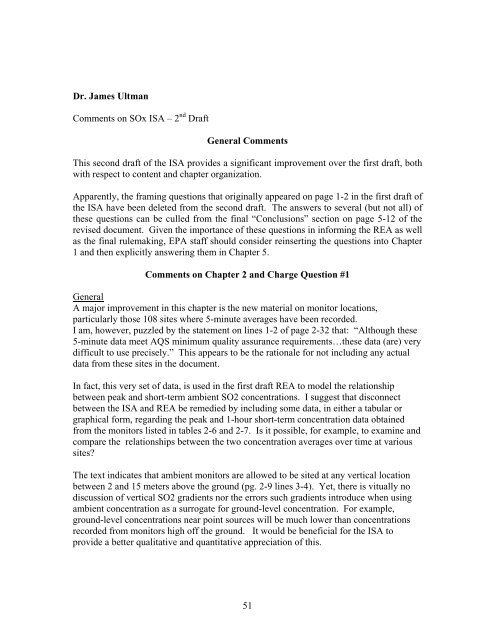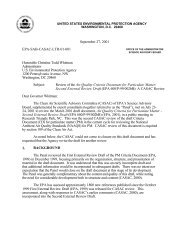(CASAC) Peer Review of EPA's Integrated Science Assessment
(CASAC) Peer Review of EPA's Integrated Science Assessment
(CASAC) Peer Review of EPA's Integrated Science Assessment
Create successful ePaper yourself
Turn your PDF publications into a flip-book with our unique Google optimized e-Paper software.
Dr. James UltmanComments on SOx ISA – 2 nd DraftGeneral CommentsThis second draft <strong>of</strong> the ISA provides a significant improvement over the first draft, bothwith respect to content and chapter organization.Apparently, the framing questions that originally appeared on page 1-2 in the first draft <strong>of</strong>the ISA have been deleted from the second draft. The answers to several (but not all) <strong>of</strong>these questions can be culled from the final “Conclusions” section on page 5-12 <strong>of</strong> therevised document. Given the importance <strong>of</strong> these questions in informing the REA as wellas the final rulemaking, EPA staff should consider reinserting the questions into Chapter1 and then explicitly answering them in Chapter 5.Comments on Chapter 2 and Charge Question #1GeneralA major improvement in this chapter is the new material on monitor locations,particularly those 108 sites where 5-minute averages have been recorded.I am, however, puzzled by the statement on lines 1-2 <strong>of</strong> page 2-32 that: “Although these5-minute data meet AQS minimum quality assurance requirements…these data (are) verydifficult to use precisely.” This appears to be the rationale for not including any actualdata from these sites in the document.In fact, this very set <strong>of</strong> data, is used in the first draft REA to model the relationshipbetween peak and short-term ambient SO2 concentrations. I suggest that disconnectbetween the ISA and REA be remedied by including some data, in either a tabular orgraphical form, regarding the peak and 1-hour short-term concentration data obtainedfrom the monitors listed in tables 2-6 and 2-7. Is it possible, for example, to examine andcompare the relationships between the two concentration averages over time at varioussites?The text indicates that ambient monitors are allowed to be sited at any vertical locationbetween 2 and 15 meters above the ground (pg. 2-9 lines 3-4). Yet, there is vitually nodiscussion <strong>of</strong> vertical SO2 gradients nor the errors such gradients introduce when usingambient concentration as a surrogate for ground-level concentration. For example,ground-level concentrations near point sources will be much lower than concentrationsrecorded from monitors high <strong>of</strong>f the ground. It would be beneficial for the ISA toprovide a better qualitative and quantitative appreciation <strong>of</strong> this.51
















